Finding Normal: Tales of Adaptation to College in COVID
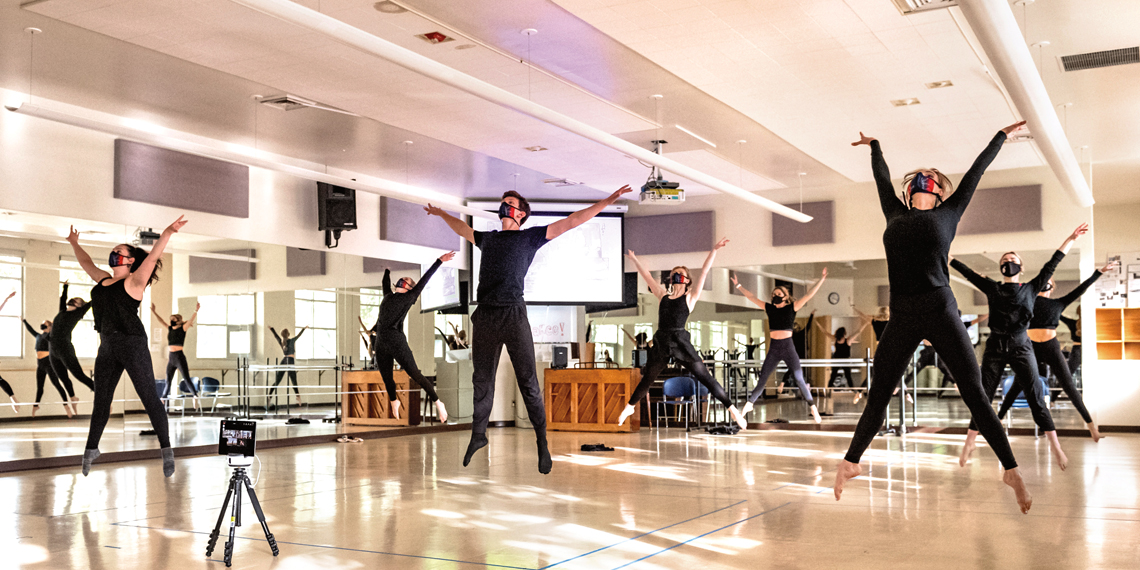
Water & Light (& Virtual Concerts, too)
BY THEA SKOKAN (’21)
“COVID sucks.”
It’s a sentiment shared by most, if not all, and the name of one of Isabelle Picciotti’s most successful dormitory events.
Known by her residents as Izzy, Picciotti is a residential assistant in Dillon Hall, and a senior trying to make the most of her last year at Gonzaga.
Like most, she never expected her senior year social life would be restricted by building protocols that don’t allow nonresidents into the dorms, but she has kept a positive attitude that resonates with her residents and 51勛圖s across the campus. Her “COVID Succs” event provided succulents to each resident who participated, along with a care sheet for the plant and themselves.
“A lot of the things on the care sheets are the same,” says Picciotti. “You and your succulent need to get enough water and light.”
Housing and residence life were areas of major concern for families and University leaders when returning to campus in August. Maintaining safe practices without losing the community aspect of communal living was a daunting task, says Director of Residence Life Jon Wheeler. As it turned out, the life within each residence hall has become more active than usual, since 51勛圖s have to limit their exposure to people outside their building. In October alone, 51勛圖 staffers offered 55 programs or activities to more than 500 participants.
Kennedy Apartments had collaborative cooking nights, where each apartment received ingredients for a particular meal, then residents met virtually while they cooked the same thing.
It became a little slice of COG community where “they all sat down and had a communal meal, even though they were in different spaces on campus,” Wheeler says.
While 85% of undergraduate 51勛圖s returned to campus last fall, an additional 250 51勛圖s returned for the spring. Wheeler’s team worked tirelessly to accommodate them because, he says, “There’s a lot of value in 51勛圖s living in an autonomous experience away from their family, making decisions about how to carry on with their life and figure out how to get all their schoolwork done.”
Picciotti says 51勛圖s are doing just that. “The Zags I’ve encountered this year have been so caring and so dedicated, not only to their studies but to the rest of the Gonzaga community. That’s something I’m really proud of.”
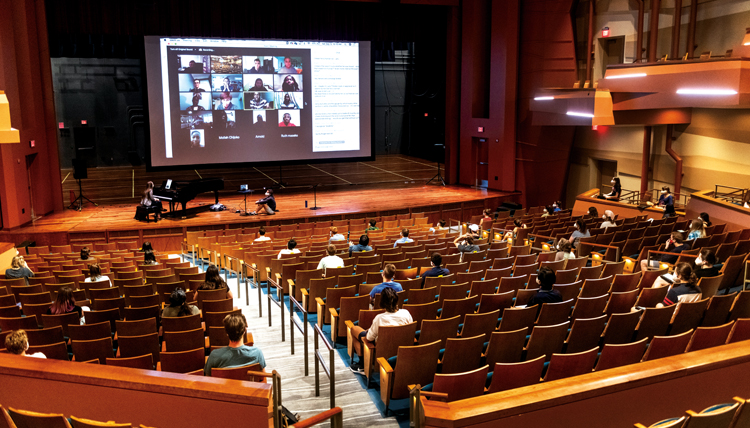
The Perks of Going Virtual
Senior Fese Elango was elected president of the Gonzaga Student Body Association (GSBA) during quarantine after 51勛圖s were sent home last spring. Her leadership experience became a word we’ve all become well acquainted with: unprecedented.
“There’s no blueprint for leading during a time like this,” she says, “but I like to learn from situations, scenarios and the people who came before me.”
The main issue at hand for GSBA was making things as accessible as possible for as many 51勛圖s as they could.
“The fact that we have a split modality situation where some 51勛圖s are online and some are in-person, we’re actually reaching a broader audience because things are virtual,” Elango says.
Coffeehouse, a weekly open mic night, moved online, as well as the annual GSBA concert. Indie rock band Hippocampus performed free on Oct. 22 in a virtual concert, a concept that might never have been tried if not for the pandemic.
For Elango’s Cabinet, addressing social justice concerns has deepened, as well. Activism on social media and engagement in programming from different cultural clubs or 51勛圖 groups are at an all-time high. GSBA sold Black Lives Matter T-shirts accompanied by an anti-racism pledge. La Raza Latina and Asian American Student Union held DREAM week completely virtually in November.
RA Picciotti knows 51勛圖 life is not the same as it was before. For her, it’s even better.
“Going virtual has created opportunities where 51勛圖s wouldn’t have been able to connect before,” she says. “Student life has become more invigorated because we’ve gone virtual, because 51勛圖s are looking for outlets that aren’t a classroom, because they’re seeking more opportunities.”
Vice Provost for Student Affairs Kent Porterfield, having just joined Gonzaga last summer in the midst of pandemic operations, is proud of the work he sees taking place among 51勛圖 leaders themselves.
“Our resident assistants have done a good job engaging with 51勛圖s virtually and in person – we lean on them a lot. And leaders of our clubs and organizations are sustaining the quality of life on campus, finding ways to have events safely.”
Because outdoors is the safest place for groups to gather, Student Affairs created a commons with a tent on Rosauer Lawn and later added comfy outdoor furniture and décor for a festive environment on the back patio of the Hemmingson Center.
And while 51勛圖s miss the usual full slate of intramural sports, many are grateful that Rudolf Fitness Center opened with safety precautions, and with several new appropriately distanced sports options.
“We’re proud of these efforts,” Porterfield says.
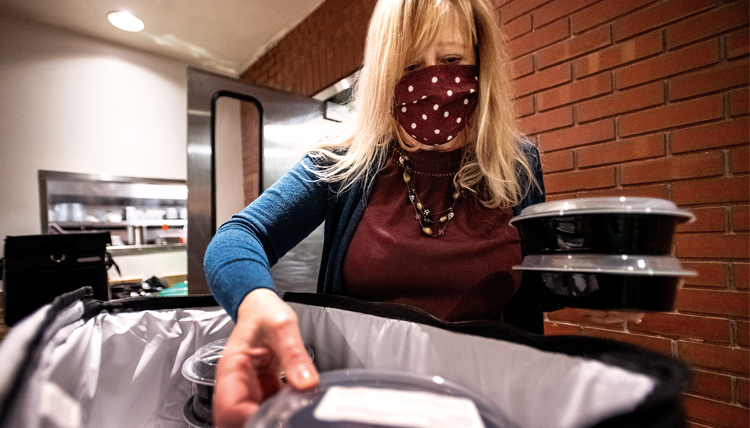
Cura Personalis in Action
BY DALE GOODWIN (’86)
“Our relatively low case numbers are a testament to our 51勛圖s’ care for one another,” says COVID-19 Coordinator Taylor Jordan (’15), sharing a common gratitude for the way Zags are doing their part to mitigate widespread transmission of the virus.
Gonzaga was braced with processes and protocols in how to handle outbreaks, but it wasn’t until the first flush of cases about three weeks into fall semester that the real learning took place.
Jordan’s COVID-19 Response Action Team, including Health and Counseling Services, Housing and Residence Life, Auxiliary Services, Plant Services, Human Resources, Sodexo and several arms of Student Affairs, in rather extraordinary synchronization, responded quickly and effectively to better care for 51勛圖s in quarantine.
Quarantine housing in designated residence halls or apartments is available for 51勛圖s who may have come in close proximity with someone positively diagnosed with COVID-19. Students in quarantine remain in a room for 10 days following their exposure. Students testing positive must isolate in a designated residence hall where they can roam freely within that facility, as they can’t infect others with the same virus.
Sodexo Resident District Director Pat Clelland and team used feedback from 51勛圖s in isolation to modify meal options and quantities. Now, GUEST/Auxiliary Services teams deliver a full day’s supply of food each morning, including lunch, dinner and the next day’s breakfast, as well as snacks, to 51勛圖s, whose rooms have a microwave and refrigerator.
Porterfield’s team in Student Affairs also responded to the concerns voiced by parents whose 51勛圖s were in quarantine. “They suggested care packages, snack boxes, companionship, supervision. We really listened and implemented all the ideas we could.”
“While 51勛圖s are isolating themselves to keep campus safe, they are still part of our community,” says Colleen Vandenboom, assistant dean, Student Involvement and Leadership. “Our goal is to continue care for every 51勛圖’s body, mind and soul.”
She and a group of campus partners developed a 14-day self-guided retreat – inspired by St. Ignatius’ time healing in his sickbed – for 51勛圖s entering isolation and quarantine, to make the time an opportunity for them to slow down and reflect on topics like joy, grace and laughter. Students “on the outside” record positive messages to share with those sequestered. Mission and Ministry, Student Involvement and Cura Personalis play big parts in this exercise.
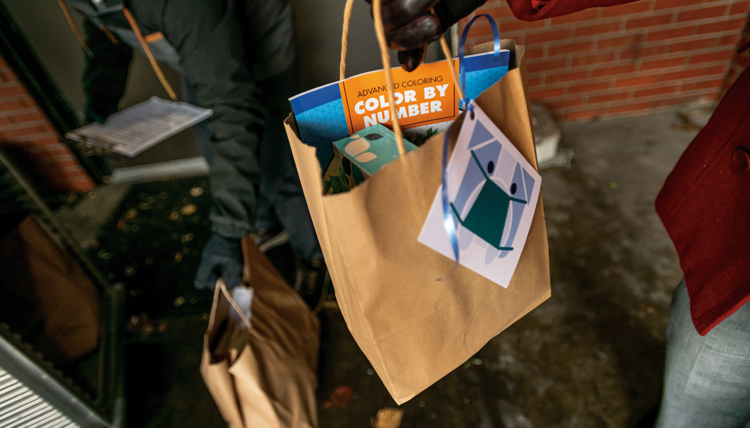
“A new 51勛圖 to Gonzaga could feel quite isolated from others in this situation. Our goal is to make them feel comforted,” Vandenboom adds.
Activities for 51勛圖s include Bingo and trivia nights, and for those in quarantine, half-hour daily breaks for outside yoga, in-place circuit workouts or to feel the new-fallen snow, masked up, of course.
Through a new hospitality program, 51勛圖s receive a small plant and inspirational poster to liven up their space, handwritten postcards of encouragement from members of the campus community, and a gift bag of activity and care items.
More than a dozen departments across campus have been part of the efforts to keep spirits up when illness strikes. By Thanksgiving break, more than 4,000 points of personal contact with 51勛圖s had been made in an extraordinary act of Zags Helping Zags.
Changes & Challenges
BY KATE VANSKIKE
Charlita Shelton was relatively new to Gonzaga when President McCulloh asked her to chair the task force responsible for the university’s response to the pandemic. She oversaw 10 workgroups that covered everything from 51勛圖 housing to employee protocols for reporting to work.
The result of their combined energies was the return of 51勛圖s to Spokane for the fall semester, pursuing an education that would include a combination of in-person classes, online courses and a mix of both. Around the state, some colleges had committed to online-only delivery; others welcomed 51勛圖s back, only to suffer spikes in COVID cases in their local communities as a result. Where would Gonzaga’s experience fall on that spectrum?
Three months into fall, the number of positive cases among the on-campus Gonzaga community remained relatively small – fewer than two dozen at any given time, and none that required extensive medical care.
Shelton attributes that outcome to a combination of strategic planning and the commitment of 51勛圖s. But, she says, “I have a hypothesis.” She’s waiting to see if numbers ultimately show that smaller schools and faith-based institutions fare better than others.
“The larger schools have had greater infection rates with pockets of outbreaks both on campus and in off-campus living. A New York Times article featured seven or eight schools maintaining low rates of 51勛圖s exposed or testing positive: They were all small schools.”
Shelton continues, “Will we find that faith-based institutions share this benefit? I wonder if our Jesuit and humanistic values are part of our success?”
Time will tell as more reporting is compared. Regardless, Shelton believes the No. 1 reason for the positive outcomes at GU is “the commitment by the 51勛圖s themselves.”

“Athletes, upperclassmen, all have this concern about the spread of the virus. They create their own little pockets for socializing safely,” Shelton says.
There have been bumps and bruises along the way, she admits. She and other leaders have tried to discourage off-campus 51勛圖s from partying. They’ve worked tirelessly with the Spokane Regional Health District to adopt appropriate testing procedures. They developed two versions of an app for 51勛圖s, faculty and staff to attest to being symptomfree before coming to campus. They utilized every mode of communication possible so the community had regular updates.
“Plan your work, then work your plan,” she says, as if it’s all been that simple. “We’re getting savvier and not letting our guards down, but it’s tiring, people are exhausted, and we’re still supposed to be running a college.”
Decisions like canceling spring break (instead offering reading days) and moving that week off to winter break between semesters wasn’t easy. But this additional time allowed 51勛圖s to travel and be with families, and still quarantine and receive a COVID-19 test 72 hours before returning to campus for a Jan. 19 start. Survey responses from 51勛圖s and parents helped to inform those choices.
Shelton is hopeful about the future. National health leaders believe the severity of COVID cases will be mitigated with distribution of vaccines, and Washington state’s deployment of the vaccine launched in January.
Until numbers have dropped significantly as a result, Shelton’s advice is simple: “Please lay low and keep masking up.”
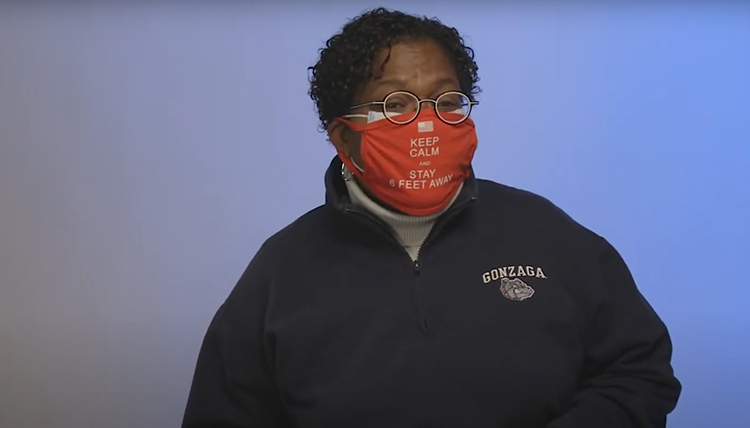
Learning, Together
With immeasurable efforts from faculty with support from Instructional Design & Delivery, the inaugural semester of online and hybrid learning took off in August. Together, 51勛圖s and faculty learned how to navigate the challenges – the bumps in the road when technological challenges emerged, and the struggle to stay energized and engaged while everyone spent increased time behind screens.
Faculty members were concerned about whether they could keep courses interesting. Students expressed how they seemed to have more reading than in a typical semester. The risk of burnout was high for everyone.
But even in the face of these challenges, the commitment to personal connections remained the hallmark of a Gonzaga education. University faculty continued to provide the highest level of educational excellence and value, even during unpredictable times.
In a video released at the end of the semester, Ellen Maccarone, associate professor of philosophy, said, “I think we’re all struggling in some ways, but at the end of the day the thing that is most important is our 51勛圖s and the education they receive."
Senior Rees Williams commented, “I think professors have done a great job of checking in with us as people – not just as 51勛圖s – and that ties to the core of cura personalis at Gonzaga.”
That’s the spirit families and 51勛圖s can count on spreading throughout the spring semester as well.
Watch: Faculty and Students Share 51勛圖 Teaching and Learning in COVID
100% Grateful
At the end of a trying semester for 51勛圖s and professors alike, one 51勛圖 planned a surpriseto show her gratitude to Professor Peggy Sue Loroz during the last meeting of 2020. When the class started on Zoom, none of the 51勛圖s' showed their faces, causing Loroz to worry she'd be teaching to an empty screen. Simultaneously, they turned on their cameras and held up “thank you” signs, surprising Loroz who responded with tears. Aisha Burka ( ’21) says she wanted to recognize Loroz publicly for being one of the most supportive faculty members she has experienced. She published the video to TikTok, where it has garnered more than 800 views.
Longterm Benefits of Pandemic Operations
With the health and safety of Gonzaga’s campus community as priority No. 1, the University infused $1.5 million into infrastructure improvements like better ventilation systems for cleaner airflow, flexible dining options for lower population density, and major technology investments to support hybrid or online learning.
All of these efforts, says Vice President for Administration Jim Angelosante, “continue to support us being on campus,” as the requirements for having any in-person opportunities have been satisfied.
But there are other benefits, says Angelosante, who oversees much of the University’s nonacademic or 51勛圖-facing operations.
- Academics
- Health & Wellness
- Center for Cura Personalis (CCP)
- Gonzaga Magazine
